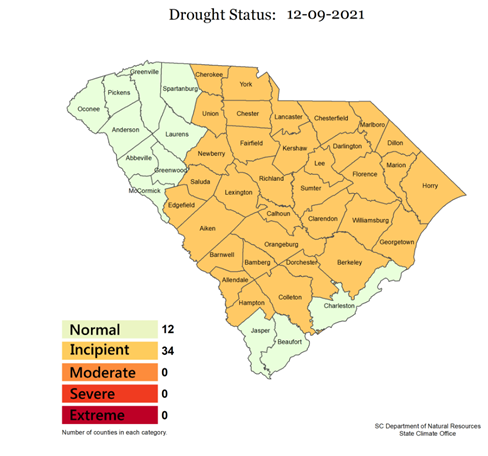SCDNR News
S.C. Drought Response Committee declares incipient drought conditions in 34 counties
December 9, 2021

COLUMBIA, S.C. — The S.C. Drought Response Committee, meeting via conference call on Dec. 9, upgraded the drought status to Incipient Drought for 34 South Carolina counties (see map).
As designated by the South Carolina Drought Response Act, Incipient is the first level of drought followed by Moderate, Severe, and Extreme. The concern over wildfires was the primary driving factor leading to the drought declaration.
Darryl Jones, forest protection chief for the S.C. Forestry Commission, emphasized that the ongoing dry conditions lately have led to higher-than-normal wildfire activity across the entire state. In November, the number of wildfires was almost twice the 10-year average, and in the first week of December, South Carolina is already more than 1.5 times the 10-year average number of fires. As the soil, leaves, and debris on the forest floor dries out, wildfires ignite much easier, and once fires start, they spread faster, burn hotter, and become much more difficult to control. Even though the state received some rain this week, it was not enough to recover the amount of moisture loss experienced, and the grasses, limbs, and leaves where wildfires start easily will dry out again after just a few days without moisture.
The Committee encourages everyone to follow guidance provided by the S.C. Forestry Commission, which includes having a fire break around the area to be burned, have a mechanism to stop the fire if it escapes, stay with the fire until extinguished and notify the Forestry Commission as required by state law when burning yard debris. See link for additional information and county notification numbers: https://www.scfc.gov/protection/fire-burning/how-to-notify/
According to Hope Mizzell, S.C. State Climatologist, there were only a few counties in the northwest Upstate and along the coastal plain that received adequate precipitation during October and November, elsewhere rainfall totals were much below normal. Rainfall during October ranged from only 0.62 inches at Fort Mill (York County) to 11.62 inches at Starr (Anderson County). November’s rainfall ranged from 0.08 inches at Wagener (Aiken County) to 4.6 inches at Bluffton (Beaufort County). Several locations reported their driest October and November on record.
Hartsville received only 0.46 inches of rain during November, which is the driest November since record keeping began in 1947. Columbia Metropolitan Airport recorded only 0.28 inches of rain, their driest November on record since the station opened in 1948.
SCDNR Hydrologist Priyanka More provided an update of the hydrologic conditions showing persistent below normal rainfall over the past couple of months have caused a steady drop in streamflow and groundwater levels. Streamflow levels at the Little Pee Dee River were below normal since September and currently have a 14-day average value at a 4th percentile flow. Similarly, the streamflow levels at Rocky Creek gage were below normal since September and have continued to remain low with a current 14-day average at 8th percentile flow. The North Fork Edisto River at Orangeburg has also reported below-normal flows beginning in November, with a current 14-day average value at 24th percentile flows. These declining trends support the decision to move most counties in the state to incipient drought status, except for a few in the Western, Central, and Southern regions where the conditions are comparatively better.
The Catawba-Wateree River Basin in North and South Carolina has had very little rainfall over the last few months. The basin is still in normal conditions but very close to the Stage 0 trigger level of the basin’s Low Inflow Protocol as of early December. If conditions do not improve with significant rainfall, the basin could enter Stage 0 in early 2022 and more severe stages could be a possibility later in the spring, according to Ed Bruce, Duke Energy’s lead engineer. The Low Inflow Protocol provides trigger points and procedures for how the Catawba-Wateree Project will be operated by Duke Energy, as well as water withdrawal reduction measures and goals for other water users in the Catawba Wateree River Basin during periods of low inflow
"We are currently in a La Nina winter, which tends to provide winter conditions that are warmer and drier than normal for the Southeast United States," said Elliot Wickham, S.C. water resources climatologist. "Unfortunately, most of the state started out dry as we entered the La Nina, which increases the potential that the drought will intensify. Winter rainfall is important for recharging our surface and groundwater resources when evaporation and demand are low."
Media Contacts:
Hope Mizzell, SCDNR State Climatology Office,MizzellH@dnr.sc.gov
Priyank More, SCDNR Hydrology,morep@dnr.sc.gov
Rob Devlin, SCDHEC,Devlinrj@dhec.sc.gov
Darryl Jones, S.C. Forestry Commission,Devlinrj@dhec.sc.gov
Katherine Helms, S.C. Department of Agriculture,khelms@dnr.sc.gov



